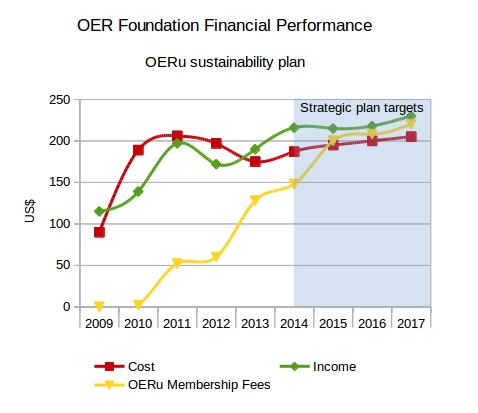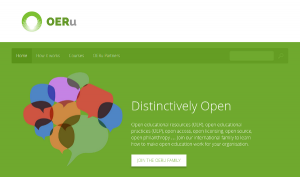OERu/Strategic plan 2014 - 2017/Strategic plan 2015 - 2017/Strategic plan/Goal 3
Contents
- 1 Goal 3: Achieve a fiscally sustainable and scalable OERu network
- 1.1 Objective 1: Recruit the minimum number of partners for a fiscally sustainable OERu network
- 1.2 Objective 2: Improve community engagement for OERu planning, implementation, technology innovation and technology integration
- 1.3 Objective 3: Diversify external funding sources for OERu strategic and research projects
Goal 3: Achieve a fiscally sustainable and scalable OERu network
The OERu network is fiscally sustainable and scalable when:
- The membership fees from contributing partners cover the central infrastructure costs for hosting free content and related technology support services without reliance on 3rd party donor funding;
- OERu partners assemble courses using open textbooks, OER and open access materials thereby reducing costs for full-fee students on campus and opening parallel pathways for assessment-only services for OERu learners;
- OERu partners recoup recurrent cost for assessment-only services, generate new revenue for value added services and deploy OERu courses for local delivery at near-zero cost;
- The OERu network diversifies revenue sources to support strategic projects for the benefit of its partners; and
- The network achieves a critical mass of active engagement from staff at OERu partners through, for example: contributing to the planning and implementation of the OERu by establishing a small community source model for technology innovation, and progressing the implementation of Academic Volunteers International.
Objective 1: Recruit the minimum number of partners for a fiscally sustainable OERu network
| Plan targets | Key performance indicator |
|---|---|
| 2014 Baseline |
|
| 2015 Operational target |
|
| 2017 Strategic target |
|
|
Risk: Without a sustainable revenue stream to cover centrally hosted services required for free delivery of courses to OERu learners the network will need to divert valuable resource time to securing third party funding sources which do not provide a viable long term solution. | |
Established in May 2009, the OERF has built a solid financial model and foundation for achieving a fiscally sustainable OERu collaboration. Currently, approximately 72% of the operational costs of the OERu collaboration is recovered through membership fees. During the inception years of the OERu initiative, the generous funding support from the William and Flora Hewlett Foundation has enabled the OERF to achieve the critical mass of OERu partners for a viable international partnership. The OERF has also received nominal financial support from the Commonwealth of Learning equating to approximately 7.5% of the annual operational cost of the OERu project.
The OERF has pursued additional project and contract work to reduce the cumulative deficit during its formative years. However, this contract work contributes to unwelcome mission drift by utilising scarce resources for projects not directly related to the implementation of the OERu. Fortunately, the OERF is forecasting that by the end of the 2014 fiscal year, it will wipe out the accumulated deficit to commence the 2015 - 2017 strategic plan without any debt burden, unlike a number of the commercial MOOC start ups which will need to recoup multi-million dollar investments from venture capital funding.
As an independent non-profit organisation, any surpluses must be reinvested back into charitable activities for the benefit of the OERu network. While the generation of any surpluses is not a major focus during this consolidation phase of the OERu plan, should the recruitment of new members exceed our targets these funds could be, for example, reinvested in commissioning the assembly of OERu courses or contributions to additional support for the OERu infrastructure.
Strategic approach
The strategic approach for the OERu 2015-2017 plan is to:
- Contain operational costs for the central OERu infrastructure to around US$200,000 per annum for the duration of the plan;
- Achieve break even for operational costs from OERu membership fees without reliance on 3rd party funding with a small margin to compensate for unforeseen membership attrition;
- Avoid reliance on 3rd party funding for OERu operational expenditure.
Open technology principles
The OER Foundation provides a centrally hosted technology service based on open source software for the collaborative development of OERu courses and delivery at no-cost to the learners. The costs of hosting this infrastructure is funded through OERu membership fees. We subscribe to the following principles:
- All learners should have unrestricted access to all course materials without the need for password access.
- To maximise reuse across the network we encourage partners to develop courses using the WikiEducator content repository. In cases where partner institutions choose to host courses using their own delivery technologies, they are responsible for the full costs of hosting these resources for all OERu learners.
2015 operational considerations
- Establish a working group to support the OERF with membership recruitment (or maintain this portfolio as part of the Marketing, Recruitment and Communication working group).
- Seek advice and support from the OERu Council of Chief Executive Officers on achieving recruitment targets and the achievement of operational priorities.
Objective 2: Improve community engagement for OERu planning, implementation, technology innovation and technology integration
There are three components to the community engagement objective:
- Improve active partner and community engagement with the capability to support open planning and implementation of the OERu
- Build a sustainable community source model to support technology innovation of OERu systems and integration with extant campus-based systems
- Design processes and support mechanisms for the establishment and operation of Academic Volunteers International (AVI).
| Plan targets | Key performance indicator |
|---|---|
| 2014 Baseline |
|
| 2015 Operational target |
|
| 2017 Strategic target |
|
|
Risk: Unnecessary duplication of effort in the absence of tacit knowledge and experience gained through active participation in the OERu planning and implementation process and material constraints holding back technology innovations for the network. | |
- The technology infrastructure of the OERu is based entirely on open source software generating opportunities for building a community source model whereby partners could contribute open source coding time for technology innovation and seamless integration into the local institutional delivery platforms.
- The open design approaches and transparent planning model of the OERu implementation can contribute to considerable efficiency gains for the network. However, many staff at our partner institutions are not experienced with open planning processes and open collaborative design models.
Strategic approach
- Incremental design is the preferred modus operandi to ensure agility of the OERu network.
- Open communication with a transparent public record of decisions aims to build community and facilitate long term sustainability.
- To scale capability development the OERu advocates a "pay it forward" model, where the beneficiaries of new OERu skills are encouraged to repay their learning by helping a new community member in the future.
2015 operational considerations
- Increase OERu partner representation on the active working groups.
- Undertake an inventory of partner institutions to identify open source skill sets within the network and corresponding activities to nurture the development of a community source model.
- Implement activities to promote capability development of partner institutions in open planning methodologies.
- Promote OERu community building.
- Devise induction and support mechanisms for new OERu partners.
- Progress the Academic Volunteers International process framework to communicate OERu needs and to coordinate active involvement of the volunteer community.
Objective 3: Diversify external funding sources for OERu strategic and research projects
The OERu is a unique international charitable collaboration. The network draws its strength from our international diversity, currently with thirty six partner institutions from six global regions of the world working at the contemporary nexus of OER, open online courses and virtual mobility towards more affordable credentials. Our network generates opportunities for diversifying funding sources from the international donor community for strategic projects. In addition, our commitment to open data and open planning provides attractive opportunities for research funding to inform and facilitate the implementation of the OERu.
| Plan targets | Key performance indicator |
|---|---|
| 2014 Baseline |
|
| 2015 Operational target |
|
| 2017 Strategic target |
|
|
Risk: Strategic development in the following areas will be curtailed: Achieving a critical mass of baseline courses designed for international reuse for formal academic credit; technology innovation for collaborative delivery in parallel mode; and research to inform the implementation of the OERu model | |
The OER and open access movement has made considerable progress producing a large and impressive inventory of OER, open textbooks and open access research outputs. However, there are few courses incorporating a range of pedagogical elements for independent study which are designed for reuse for formal academic credit across multiple institutions and international boundaries, and which are published under open licenses and editable file formats. The OERu model provides fertile ground to attract seed funding to assemble a critical mass of reusable university level courses designed for cross-border education which could support the OERu priority of rapidly developing product for the OERu collaboration.
The availability of OER is no longer a significant issue. The modern challenges include:
- providing collaborative ways for educators to adapt and extend existing resources; and
- providing a federated, networked delivery model that allows institutions to share their course offerings.
A central repository or even a network of repositories is not enough. A federated system either in the cloud, or more excitingly built within the user's browser (pulling resources and functionality from around the Internet) would permit student identity to persist across courses and allow educators to aggregate the elements and services upon which they base their "course." The web platform has the adaptability and extensibility to allow a component model to be developed that would exceed the capabilities of existing resource standardization attempts.
Strategic approach
- Focus collaborative grant proposals on strategic projects which build future capability for the implementation of the OERu and the international OER ecosystem without creating dependencies for ongoing operational expenditure.
- Support research funding proposals that use OERu open data and publish findings under free cultural works approved licenses.
- Encourage open and transparent development of collaborative OERu funding proposals.
2015 operational considerations
- Establish mechanisms for coordinating the development of OERu strategic initiatives and supporting associated research projects that could attract external funding.
- Identify strong candidate projects for external funding.

